 Objective
Objective
TODO: Acquire a "deep blue, precious mineral" and (presumably) bring it near the "encrypted" pages to decipher them and reveal their text.
This is the online version of the Lapisworks documentation.
Entries which are blurred are spoilers. Click to reveal them, but be aware that they may spoil endgame progression. Alternatively, click here to get a version with all spoilers showing.
The past is a foreign country; they do things differently there.
 Lapisworks
LapisworksI have found a seemingly obscure branch of Hex Casting, "Lapisworks". All of their texts are blank, but some outsider texts about the branch say they are encrypted with a "deep blue, precious mineral".
 Objective
ObjectiveTODO: Acquire a "deep blue, precious mineral" and (presumably) bring it near the "encrypted" pages to decipher them and reveal their text.
 Eureka! Lapis Lazuli
Eureka! Lapis LazuliI held the deep blue mineral known as "Lapis Lazuli" near the pages of the book and the mineral was sucked into them. I tried to get it off but had to be rough, and when I looked at the pages to check their condition, they had text on them! It seems I need to rub Lapis Lazuli on them to see their text. Let's see..
The branch of Lapisworks is all about harnessing the enchantment powers of Lapis Lazuli and enhancing one's own body with it. To do this media is struck into Lapis Lazuli, forming a loosely-held-by-media material known as Amethyst Lazuli, or Amel for short. The media breaches the mineral's surface and cuts the Lapis Lazuli into many extremely small chunks then connects them like a glue. Continued..
This allows any outside media to suck out all the enchantment energy of the Lapis Lazuli by interacting with the Amel's media layer. While I have found many patterns (documented just beside this entry), some pages of the texts remain blank and not even rubbing with Lapis Lazuli or Amel can decipher them. I suppose I will find out soon enough (or even never as the deciphering could be lost to time) and must be content with what I have now.
 Lapisworks Patterns
Lapisworks PatternsTransform all the Lapis Lazuli in my other hand into a loosely-held material called Amethyst Lazuli or Amel for short. Costs twice the number of Amethyst Shards as Lapis Lazuli in my offhand.
Transform all the Amethyst Lazuli in my other hand into Amethyst Shards. The Lapis turns into a fine mist which spreads quickly in the air. Excess shards spill onto the ground. Costs one Amethyst Shard.
While I could shape Amel into whatever I want, I have decided on four primary shapes which are familiar to me. I can use this pattern to mold the Amel in my offhand for free.
The next patterns enchant various parts of my body, but cost some Amel (from anything I have equipped, then from my hands and then from my hotbar) and media in return. They have no waste, so if I provide a number higher than the limit it does not cost media or Amel above that limit, but it also does not enchant above that limit. It is worth noting here that the next patterns can enchant my body, but the enchantments disappear upon death. It's a good thing every "death" of mine has so far been a bad dream.
Pass in an entity and a number of half-hearts, and it enchants that entity's skin thus increasing their health. The Amel cost is the number given and the cost in media is twice the expended Amel.
The limit to this is 2x the entity's maximum health. Curiously, the enchanted skin also protects against Nature taking it's due meaning it becomes impossible for Nature to take a piece of the entity's mind. Interestingly enough, old texts suggest that beyond a certain level of power mages would lose sanity, and this is how certain powerful mages were able to keep their sanity. In any case my maximum healthiness is about 20 half-hearts.
Pass in an entity and a number of half-hearts, and it enchants that entity's fists thus increasing their damage per hit. One Amel and five Amethyst Shards per half-heart. Limit is four times the norm or just four for me.
Enchants the given entity's feet to increase their movement speed. Costs 1x Amel and 5x Amethyst Shards. Limit is 3x the norm. The norm for me is about 1.
Enchants the given player's arms, increasing their attack speed. Costs 1x Amel and 16x Amethyst Shards. Limit is 4 PLUS the norm.
Gives you the amount the given entity has been enhanced in the given area (specified by number). The patterns before were sorted so 0 gives max health, 1 gives attack damage and so on. Negligible media cost.
 ENCHANTMENTS
ENCHANTMENTSI HAVE SEEN I HAVE SEEN I NEED IT I NEED MY SANITY BACK ENCHANT SKIN CAN I ENCHANT MIND PLEASE MUST NOT LOSE SELF TAKE FIVE MINTUE BREAK NO HAVE NO TIME MUST DOCUMENT BEFORE
THE EMPTY PAGES. THE RADIANCE IN THE CORNERS OF MY VISION GATHERED TOGETHER. DEBILITATING EFFECT ON MY SANITY, I FEEL LIKE I'M ABOUT TO I CAN SEE I CAN SEE I CAN READ MUST WRITE DOWN. ALL OF THESE PATTERNS COST 64 AMEL FROM MY OFFHAND IF NOT STATED, AND THE ENCHANTMENTS DO NOT CARRY OVER BAD DREAMS IN WHICH I DIE.
GIVEN AN ENTITY AND AN ENCHANTMENT ID, GIVES THE LEVEL OF THE ENCHANTMENT ON THE ENTITY FOR NEGLIGIBLE COST. NO AMEL REQUIRED. DOES NOT REQUIRE AN ENLIGHTENED MIND.
ENCHANT AN ENTITY'S FISTS WITH FIRE, AND IT WILL HENCEFORTH LIGHT ANY ENTITIES IT HITS ON FIRE FOR THREE SECONDS. CONSUMES 10 CHARGED AMETHYST. HAS 1 LEVEL. ID = 0.
ENCHANT AN ENTITY'S FISTS WITH LIGHTNING. CONSUMES 20 CHARGED AMETHYST PER LEVEL. 3 LEVELS, EACH IMPROVING THE USER'S ABILITY TO CHANNEL LIGHTNING. ID = 1.
LEVEL ONE: EACH STRIKE CHANNELS THE LIGHTNING IN A THUNDERSTORM TO THE STRUCK VICTIM.
LEVEL TWO: STRIKES HIT WITH LIGHTNING UNDER RAIN AS WELL.
LEVEL THREE: SO GREAT EACH STRIKE IS EMPOWERED WITH LIGHTNING, NO MATTER THE WEATHER CONDITIONS.
ENVELOP FEET WITH AMEL THAT SPROUTS OUT TO BREAK ANY FALL 10 BLOCKS (PER LEVEL) OR BELOW. NO DAMAGE REDUCTION. TWO LEVELS. 5 CHARGED AMETHYST AND 32 AMEL PER LEVEL. ID = 2.
GIVES ME MORE LUNG CAPACITY, SIMILAR TO THE RESPIRATION ENCHANTMENT BUT TWICE AS STRONG. TWO LEVELS. 1 CHARGED AMETHYST AND 10 AMEL PER LEVEL. ID = 3.
WIELD THE ENERGY OF AN ENTIRE STACK OF AMEL AND TEN PIECES OF CHARGED AMETHYST TO MAKE ONE HELL-BORNE! (FIRE WILL NO LONGER HURT THEM) ID = 4.
 Enchanted Patterns
Enchanted PatternsThese ancient texts recount an old and wise wizard, extremely knowledgeable of all sorcery, yet spiteful of all creatures living, dead, undead or unborn. It is told they were poor in sources of media and many came after them, but theyalways managed to survive. This wizard left behind a treasure trove of knowledge on their demise (collected by curious adventurers) including Enchanted Patterns.Will I ever be capable of this feat?
Frustratingly enough, the wizard attempted to burn most of them and was extremely successful, leaving only a few that were recovered by the heroes that defeated them. Among these few are enhanced forms of Conjure Block, some Vector patterns, Archer's Distillation, among some others.
Pass in a vector within Ambit and a dye color, to conjure a fragile but solid, colored block. This costs two amethyst dust and the number states which dye I want to dye the colored block. More explanation on the next page.
The number states the index (starting from 0) of the dye I wish to use if they were all sorted alphabetically. All mappings:
0 - Black 1 - Blue
2 - Brown 3 - Cyan
4 - Gray 5 - Green
6 - Light Blue 7 - Light Gray
8 - Lime 9 - Magenta
10 - Orange 11 - Pink
12 - Purple 13 - Red
14 - White 15 - Yellow
Additionally the block glows with the dye of my pigment's color and purple if no such dye exists.
Evaluates (exactly like Thoth's Gambit) the given pattern list over a hollow sphere with the given radius (non-decimal, at least 1, at most 64) around the given position.
Evaluates (exactly like Thoth's Gambit) the given pattern list over a (hollow if given True) cube-ish area from the given points A to B.
Negligible cost. Answers the question, "is there nothing there or between this place and there?". Both vectors must be in my ambit. Requires a player to cast it.
Answers the question, "is there only air there?" for negligible media cost. Vector must be in my ambit.
Returns whether the two blocks are equivalent/roughly equal (the same kind of block), so wheat seeds equals a full wheat crop. Both blocks must be within my ambit.
Returns whether the two blocks are exactly equal, so wheat seeds do NOT equal a full wheat crop. Blocks must be within my ambit.
It seems Nature searches for items by finding the first valid item in my hands starting from the hand I am not casting with. This can be quite troublesome when (e.g.) I have a Focus in both hands. The next four patterns pertain to reading and writing or checking any specific hand of mine (specified in order of importance, so 0 for main, 1 for offhand). This is also a good time to note that Enchanted Patterns aren't always "better" than the original. I wonder, if I had three arms, would these support the third as well?
Specific hand version of Scribe's Reflection. Pushes the Iota stored in the Iota holder in the specified hand to the stack.
Specific hand version of Auditor's Reflection. Pushes whether the item in the specified hand can be read from or not.
Specific hand version of Scribe's Gambit. Writes the given Iota to the Iota holder in the specified hand.
Specific hand version of Assessor's Reflection. Pusher whether the item in the specified hand can be written to or not.
 Lapisworks Mishaps
Lapisworks MishapsWith a new branch of Hex Casting comes new mishaps. I've documented them here.
I have the correct item on me, but not enough of it. Brown particles. Upends my held items and throws them to the ground.
Perhaps real enchantments like those on my tools was what those empty pages were about? Anyway. This means the entity is already enchanted at the maximum level of this enchantment. Differing particles for each enchantment, and no punishment.
This is for when I have an incorrect item in a specific hand. Drops my held items to the ground and causes brown particles to appear, while specifying what hand caused the error.
 Imbuement
ImbuementDespite Lapisworks being primarily focused on the enhancement of the body, some people have found ways to use it to enhance tools as well. Apparently some of the materials of this world have differing interactions with media. Let's see..
 Amel Storage
Amel StorageMy new tools are fun to play around with, and the Amel being able to be drawn from the hotbar is also convenient. However.. I find that some things in this field require a rather inconvenient amount of Amel to carry. For example: the partially-infused staves, while they grant me a larger hex grid, need constant repairing with Amel. Another example is the Enchant X patterns, which require a bunch of Amel as well. They make my pockets ever fuller. I cannot make much space for other things as my hands and my hotbar are unfortunately full. Indeed, I must acquire a solution.
And a solution I have acquired. By infusing just 5 pieces of Amel into an ordinary glass bottle, I can turn it into an Amel Jar which can store 4 stacks of Amel. This Jar can be worn on my belt (to prioritize it as the first source to draw Amel from), or held in my hand. I can press Use Item/Place Block with Amel in the other hand to deposit it, and if I sneak while doing it I can withdraw up to a stack of Amel at a time into the other hand.














Works the same way but stores 16 stacks and cannot be put on my belt due to it's unwieldiness. It can, however, be left in my hotbar and will still function.
 Imbue Amel
Imbue AmelThe spell the ancient "Lapisworkers" would use very often. Imbue the item in my other hand (or main if nothing imbueable is in the other hand) with the specified amount of Amel, with no waste like the Enchant X spells. Costs 2x the amount of Amel being infused, in dust.
It draws Amel firstly from anything I have equipped, then from my hands and then from my hotbar. The integer argument I provide limits it from being able to find or draw any more Amel than that.
Besides turning one item into another, this spell can also be used to enchant some things instead. For example: one use I've found is to enchant Enchanted Books that have only one enchantment. It increases the level of the lone enchantment on the book by 1 for 20 * previous level Amel and about five charged crystals of Amethyst.
 Casting Rings
Casting RingsOne of the main limitations that has kept me from making a ring to cast with is that the ring would be much too small and perhaps even inefficient. However now that I'm reviewing these texts I can see workarounds that at least limit the ring's negative effects. Some materials apparently have special interactions with media. Two examples of such materials are documented on the next page.
Diamond is a good "conductor" of media that focuses it (due to its "chemical structure" (what is that?)) while Gold is somewhat of an insulator. The "Lapisworkers" of old took these materials and combined them to make many a great constructs, but all of those (due to ease of reaction or due to wanting to hide it in war, mayhaps) have been lost to time. However I can easily create my own.













Diamond around the Amethyst to focus the media, and Gold to make sure it only flows into the Diamond. While it is still not as good as an actual staff, it is definitely more ideal than a simple ring with Amethyst. Moreover the Amethyst slightly hinders any staves I try to use by attracting some media to itself. I can press Use Casting Ring to open the casting grid when it is equipped.


If I am dissatisfied with this ring, I can choose to imbue it with one piece of Amel. The Amel should stick to the Gold part. It'll start focusing and attracting media from my reserves to moderate speed that can either be picked up by a staff in my hand or eventually swing back towards the ring.
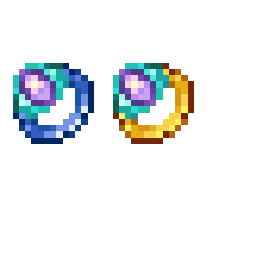
Gold is moldable too, so I can also use Mold Amel if I dislike the new appearance.
 Imbuing Staves
Imbuing StavesThe Amel Ring was created from Amel Infusion into the stave-like Casting Ring better. Therefore it stands to reason that actual staves would stand to gain from Amel Infusion. These staves (due to being larger) would need more Amel but would create a more precise staff. What of incomplete infusion, however?
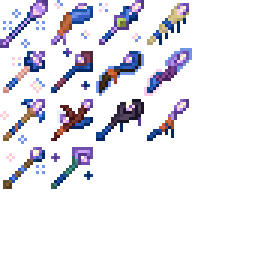
My own renditions of possible incomplete staves.
Staves that did not have the amount of Amel required to fully transform have Amel deeply rooted in their structure but not enough to stand against the power draw of the Amel for very long. The product is inefficient, leaky (and thus not very long-lasting) but also more precise (bigger hex grid) than full infusion.


The fully infused staff is less precise than the incomplete ones (has a smaller hex grid boost) but actually lasts. I suppose there is some merit, then, to having an incomplete staff and constantly feeding it low amounts of Amel so it does not decay. It takes about 10 Amel to make this.
 Imbuing Swords
Imbuing SwordsThe Casting Rings started my brain walking. The staves got it running. Now I can't stop, it's simply too enjoyable to re-invent the weapons of the past. This time I got curious about what kinds of swords could be made, so I designed some and documented them here. Each takes 32 Amel to make (with no incomplete version) and are repaired with Amel above 90% durability, but the normal material when below that.


Infusing Amel into a diamond gives it the ability to sacrifice its durability to shoot out extremely quick and focused jets of media that deal as much damage as the sword itself, when I squeeze the handle. This has a range of 10 blocks. I should infuse the Amel through the top, to sharpen it.


Iron's interaction with Amethyst Lazuli Infusion seems to be that the Amethyst Lazuli reinforces it to twice as much durability, allowing it to be feasibly used as a shield. Additionally attempting to block with it momentarily charges up the Amel like with the Amel-Infused Diamond Sword for a quarter of a second, and if hit at that point the Amel lashes out. I guess I could call this ability "parrying".
The Amel lashes out towards the other person and absorbs some pieces gaining 20 "points" of durability. It also hits the enemy with half the power of the sword (launching them away from me as well). If their tool breaks, it steals every piece, gaining 100 "points" instead of just 20. Additonally the enemy feels their tool was hit so hard they have to make sure it's not completely broken for a second or two, almost always.
The Amel has enough energy that it can even withstand an axe hit and go straight for its handle, making the enemy tool take 100 "points" of damage instead of just 20. However if I fail to parry the axe my tool takes 20 "points" of damage and I get flung away. Additionally the Amel on my sword is rendered useless for a second due to suffering so much damage while unprepared for it.


Gold is a media insulator, so I can't quite infuse Amel into a sword made of it. Still, Amel is a natural toxin to most living beings so I can pour over it and attempt to infuse it so it doesn't slide right off. Hitting entities with this makes the Amel lash out and go into them (destroying a relatively major piece of the sword as well), poisoning them for about ten seconds. Quite a nice glass cannon if I say so myself.
 Simple Artificial Minds
Simple Artificial MindsWhen I first read of the mind and that it produces trace amounts of media, I wondered, "is it possible to create a mind..?" Now after my experience with Amel imbuement, I think it is. In my experience a heap of media does not on its own start thinking, which can be explained by the fact media is merely the energy of thought. The energy must, however, be moved and used to think.
If I were to make a machine that pulls at and copies the flow of media in other organisms, such a machine would surely, with time, gain a mind. For this purpose I believe villagers are most efficient as they are not outright nearly braindead but also not truly sapient. The resultant mind will probably be concious, sapient and will bear emotions (be sentient).














The Amel will let the machine eat bits and pieces of villager minds, taking "snapshots" of the flow of media within. A Diamond should focus it enough to mimic the precision of natural minds. The Charged Amethyst will hold the mind.
This contraption can pull from the minds of three random waking villagers at most 5 blocks away at once, filling in 20 minutes from just one. A waking villager is exhausted after 4 minutes (and heals in the same amount of time when not near this machine). Sleeping villagers, if selected first (and only when selected first), aren't able to be consumed from again for 20 minutes but fill 15% of the mind container.
These Great Spells elude me so. There must be a better way than delving into old ruins to rediscover them. If the old ones discovered them on their own, so can I! To that end, I have found a way to directly ask Nature for the stroke order, however it only returns a torrent of information that must be sieved through by someone, or something.. Expendable. The spell eats over a quarter of the mind regardless of success or not. I can't imagine this experience not being excruciatingly painful.Should this bother me?
Sieves the torrent of information using the (full) artificial mind at the given position. 3/5 chance of replacing the pattern in my other hand with one of the correct stroke order.
Pushes the percentage filled of the mind container at the given position to the stack.
Absorbs the entirety of the mind within the container into the rechargeable item in my other hand. If there is any extra, it is discarded. A full container yields one Charged Amethyst.
This whole thing.. It doesn't feel ethical. I am creating conscious beings, a miracle in and of itself, and my uses for them are to KILL them for meagre amounts of media.. Like sheep if they were sapient.
Are they more? Should I care?
 Jump Slate
Jump SlateI have learned never to open those texts that require a broken mind again. They disturb my psyche tremendously, likely due to some password being required that had since been lost to time. My psyche. They touched my sanity. They tried to hurt me at my pinnacle. How dare they? HOW DARE THEY?! Stop. Keep calm. Focus. Move on. History will have taught them their error in their demise.
The constructs made of slates that were previously lost to time until I recovered them, also known as Spell Circles, are truly glorious. I adore them. I can do so much with them. However.. As much as I may love my new playthings they are not perfect so. They are grand indeed! But sometimes, I feel they are too grand. Their color clashes with the aesthetics I desire. The directrices, impeti, they look so hideous in certain builds! It pains me so! But.. With Amel Infusion I can fix this.
Amel reigns supreme when it comes to attracting and integrating into media, using it and enchanting constructs. An enchanted slate could be produced intricately and in such a manner it turns into a media accelerator not unlike my Amel Ring. It can also be amplified by media (dynamically!) to push it further, bypassing slates. This effect, I'll coin "jumping slates". My original creation. Mine. My marvellous invention, it requires only 20 pieces of Amel and has a range of 100 blocks!
It attempts to pop an integer that's not 0 or 1 off the top of the stack and take 2.5 times that in dust from the circle to jump that many blocks. Behold it's marvel, however: if it fails, it lets the flow pass straight through like it were a junction. Nothing ever escapes to the sides. What if it finds a negative number? Even better, it jumps backwards and the leftover momentum makes the Spell Circle work in reverse.
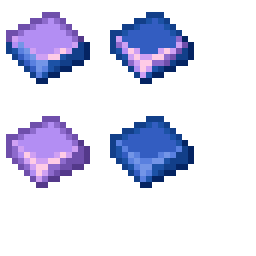
Spell Circles were revealed to ME. To ME. And I have improved Them. That's why I was granted them. I.
While the Shepherd Directrix may be the most easy-to-use for making loops, it looks unwieldy to say the least. I desire something more pretty. A Jump Slate that reverses it's direction after the jump. As an Impetus can push the flow of media, I deduce a Simple Mind would be able to do much the same. Imbuing a Simple Mind into a Jump Slate should do. I'll call my invention: the Rebound Slate, as it always directs the flow of media back to itself post-jump, except when it fails.
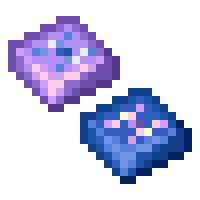
Through and through and right back around. The thought of that disturbs me yet keeps me sane.
 The Wizard's Spells
The Wizard's SpellsSome intellectuals and/or adventurers saved the old wizard's diaries. I've begun to divine some of the wizard's knowledge from these ancient tomes.
 The Ancient Wizard
The Ancient WizardI have found rumour of an old, knowledgeable wizard that has done much evil and staved off the hordes of vigilantism, yet always had low media reserves. While they attempted to burn most of their scriptures near their demise, I've read tale of adventurers and intellectuals that had managed to save some of them from the grand fire.
Based off of this information I predict they may have buried the knowledge away or put it in the strongholds I've read of, such as pyramids in the desert, brick structures underground, etcetera.
 Enchanted Sentinel
Enchanted SentinelWhilst being hunted by a particularly strong group of 30-40 people consisting of professional hitmen or assassins, bounty hunters, and other mages looking to vanquish them, the mage had escaped into a castle. They needed a way to be able to deal with all of them from a huge distance or from a few floors up. Greater Sentinel had a small area, thus small corridors would be suspicious. So out of desperation, they looked to their Amel to "enchant" the pattern.
Summons an enchanted version of the Greater Sentinel at the given position (which must be within 32 blocks around me) and the given ambit (which can be from 1-64). Costs 5 amethyst dust to summon.
This Enchanted Sentinel has much more media than a Greater Sentinel, but has chains imposed on it that make its existence dependent on me. It must always be in MY ambit (a Greater Sentinel's ambit is much too weak) or else it falls apart. It's still intangible, but it emanates particles visible to everyone. I perceive the particles as well as a media-dense being which looks like some dark purple, unnaturally twisting geometric shape.
The wizard wrote it was created by forcing Amel into the original pattern and molding it violently, shaping the media within to their will. The result is a "4-dimensional spinning hypercube projected as a tesseract!" (what does that even mean??) which has some form of feeling and awareness. It knows it's chained to it's user, forced to follow their whims due to being dependent on their media. They write of this fondly, as if they take pleasure in it.
Peacefully put my Enchanted Sentinel to rest for a negligible amount of media, letting it rest for a time. Perhaps the ethical option, considering "falling apart" may not be the most painless.
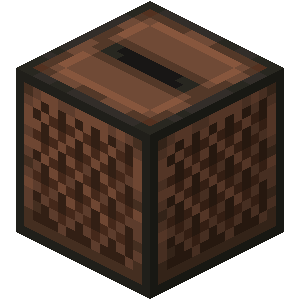 Imbue Mind
Imbue MindMost of the pages are burned, and only the pattern with it's documentation remains. Unfortunate.. In any case, I've documented the pattern on the next page and then it's uses on the pages after it.
Takes the location of a block with limited functionality and a full Simple Mind Container, and imbues the mind into the construct for five charged amethyst. This shape reminds me of something..
Due to the bottom 90% of these pages being burnt away I can't see what the wizard had to say about them, but they all have a smile drawn in red ink next to each of them.. Should I be concerned?

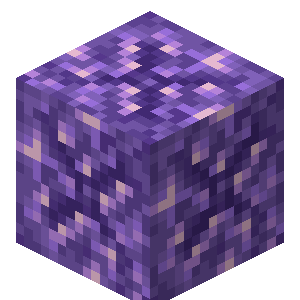
An Amethyst Block, when imbued with a simple mind, turns into a Budding Amethyst block. Nothing too special, really. But I do wonder, if minds can be put into these blocks to make more amethyst, where did all the amethyst that's already here in this world come from?

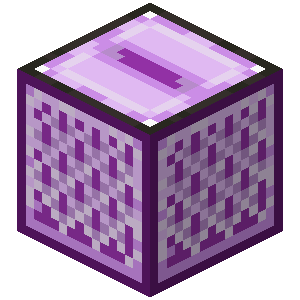
"A mind so simple can be imbued into functional blocks with great ease and without stripping away unnecessary parts." I believe this line refers to the Jukebox on the same page (and others on other pages), which can be turned into a Live Jukebox. A Live Jukebox can be taught to play notes at a frequency, and then hit to play those notes.
Teach the Live Jukebox at that location these notes (a list of whole numbers 0-24) at this frequency (0-20). After being hit via Use, it plays the notes like an automatic Note Block.
 Hastenature
HastenatureThis one was created when the wizard was extremely adept at pattern infusions with Amel, their final days. They were a master of it, to the point their infusion created extra patterns, or byproducts. The main pattern here was one that was supposed to be one that'd age enemies to death, a horrifying spell the pattern for which - for better or for worse - was burned.
Takes a block position and a positive number, and ages the block (or how I call it, induces a random tick) there that many times. Costs an amethyst shard per age-up.
 Interop
InteropThe branch of Lapisworks has no problem interoperating with any other addons that I have installed on my world.
 Lapixtended
LapixtendedSo many staves! So pretty! I must model incomplete Amel-infused versions of all of them!
I tried to give Obsidian a "crying" look, much like Crying Obsidian, however it was unfortunately too thin for that to look good on it.
Moreover, I believe the functional Amethyst staves are already good enough.
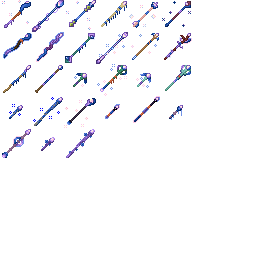
The wands take 20 Amel to fully infuse, but are more precise.


The unique energy that entities give off I cannot emulate. However, Amethyst Lazuli does have a pretty large presence. Thus, the Amel-tuned Orb, made from infusing 10 Amel into a Drawing Orb. It is a device which can turn 10 Amel into particles unfathomably small at my head position, and arrange them into an ever-reshaping line between it and the orb. The line can stretch across truly vast distances to provide me about three blocks of ambit around the set position as long as the orb is in my hand, the mysterious forces of chunkloading notwithstanding. I should note that the Amel can never return to it's solid form.
 Lapixical
LapixicalThe Lightning Rod Staff is great, but it makes me wonder: What if I put other things in it's cradle? I theorize that I can use Amel to focus the media and hold any item in place indefinitely, similar to how a staff can work indefinitely. Placed upon the rod, it gives the impression of a wand. My hexes are also able to access the item within via (for example) Scout's Distillation. (I tried hard to make the area within which my hexes detect it bigger, however I unfortunately failed to do so.)






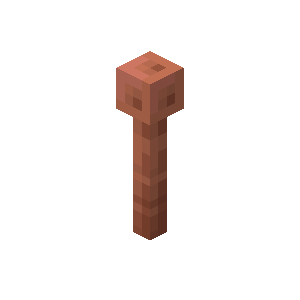
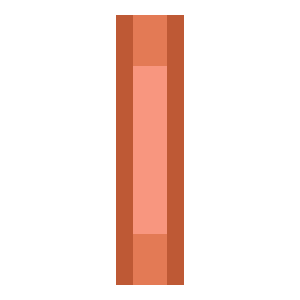












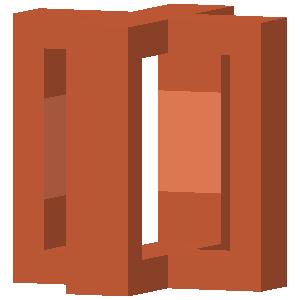
A decomposition of the staff.

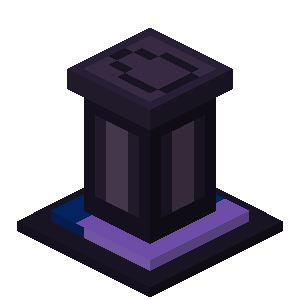
The Pedestal does not have any shortcomings, yet as with all things, it is not perfect. It can ony act as my off-hand, yet there are many examples of patterns that work with a specific hand. Amel Infusion has focused those to their specific-handed versions, thus I see no reason why it wouldn't work with the Pedestal. 15 Amel should do.